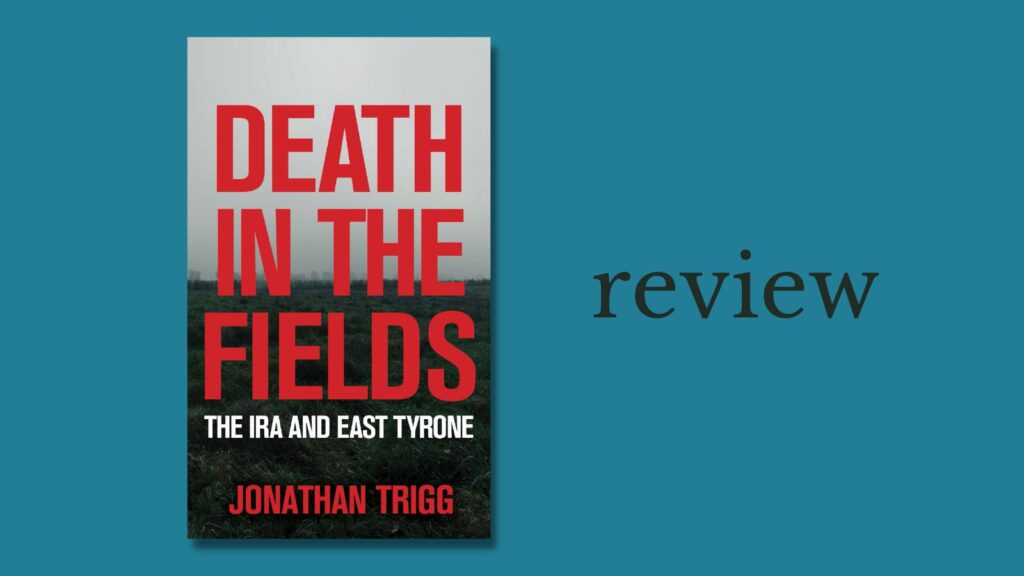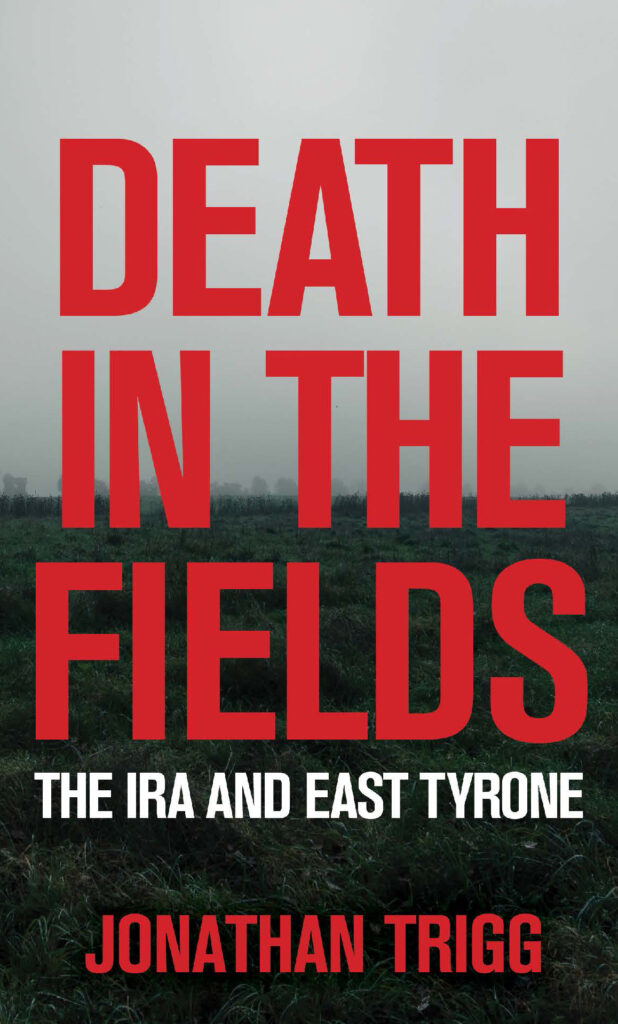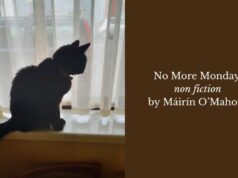
Death in The Fields: The IRA and East Tyrone|Jonathan Trigg|Merrion Press|€18.99|ISBN: 9781785374432
Murky worlds and blurred lines —John Kirkaldy reviews Death in the Fields
by John Kirkaldy
This is not the book for a late night read. In almost every other paragraph, somebody dies, usually in gruesome detail. There is a long chronicle of assassinations, shootings, ambushes and bombings—interspersed by the occasional kneecapping, ‘own goal’ detonation, torture, robbery and beating.
Death in the Fields: The IRA and East Tyrone is an account of the Provisional IRA in that area from the start of the Troubles in the North to its ceasefire in 1997. The area had a long tradition of republicanism and it soon earned a reputation by the deadly nature of its attacks. ‘In Belfast, the Provos were trying to make the six o’clock news, in East Tyrone, they were trying to kill you,’ was the conventional British Army wisdom.
Murky worlds
It describes a very murky world of not only the IRA (Provisional but also the Officials) and the Army, but also the INLA, RUC, RUC Special Branch, SAS, UDR, UVF and UFF. The lines between some of these were often difficult to define and were often blurred.
Just as my freedom fighter is your terrorist, so too is the distinction between intelligence gathering and informing. There was also the sometimes-fluctuating level of support for the paramilitaries amongst the Republican communities and those in the Loyalist ones. On top of all this were occasional policy changes by successive British and Irish Governments.
Trigg states that he has had interviews ‘with veterans from all sides in the conflict.’ The list is impressive with some on the record and others not. The book claims to be the story ‘as told by the people who fought it.’
Just as my freedom fighter is your terrorist, so too is the distinction between intelligence gathering and informing.
It is perhaps a reflection on the passing of time that such a statement could be made—but has there ever been a truly 100% objective account of the IRA? It should be noted that the author served in the British Army with first-hand experience of Northern Ireland, but he is also the author of ‘over a dozen books of military history.’

Early campaigns
The IRA in East Tyrone was helped by geography: two towns, Cookstown and Dungannon, with small villages surrounding them in an overwhelmingly rural setting. Local knowledge was of enormous benefit.
As civil rights became absorbed into more fundamental issues in the early 70s, so the local IRA began its campaign, led by iconic figures, such as Kevin Mallon and Kevin McKenna. In December 1971, it killed its first UDR member, Denis Wilson and in March 1972 its first RUC officer, William Logan.
In September 1972, it detonated a landmine under an Army Saracen, which killed three soldiers. In the early days, the IRA’s main worries were a lack of arms (the local Officials branch handed over some of theirs) and money (robberies were authorised to boost funds).
Late 70s and 80s
The situation changed in the late 70s and 80s. The Army developed Close Observation Platoons (COPs), whose main job was intelligence collecting. The SAS was first deployed in Northern Ireland in February 1976.
The IRA developed Active Service Units (ASUs) with about four to eight volunteers, which operated as an isolated unit. Imprisonment was having a major impact on numbers. In 1977, 1,308 people – mainly republicans – were charged with terrorist offences. New leaders emerged, such as Jim Lynagh, Pádraig McKearney, Patrick Kelly and Gerard O’Callaghan.
All sides involved realised that it was a propaganda war and had sophisticated briefing arrangements (I can vouch for this, as a freelance journalist writing occasionally for Australian media outlets at this time). In 1985, Muammar Gaddafi, the Libyan leader, impressed by the Hunger Strikers, had sent the IRA large supplies of arms and two million pounds in cash.
All sides involved realised that it was a propaganda war and had sophisticated briefing arrangements
Probably, the most dramatic encounter in the whole period was the IRA attack on the RUC station at Loughgall in May 1987. The idea was simple and dramatic; a digger with 200lbs of explosives would be driven to the station and detonated. Unfortunately for the IRA, the SAS had very accurate inside information and an ambush was prepared. The building received extensive damage but all of the IRA’s A team, who were involved in the attack, were killed. The source of this information is still disputed.
The long wind down
In a final chapter, entitled The Long Wind Down, Trigg analyses the factors behind the IRA Ceasefire in 1997 and the reasons for it in East Tyrone and the North generally. Another botched major attack in Clonoe in February 1992 failed again because of inside information. The IRA in the area increasingly used long range mortar attacks, rather than direct assaults. The Loyalist paramilitaries in East Tyrone were starting literally to call the shots in the area. The number of willing volunteers was also in decline.
A number of killings over the years appeared to be sectarian, such as the shooting in cold blood in January 1981 of eighty-six-year-old Sir Norman Stronge, as he and his son watched television.
According to Gerry Adams in an IRA commemoration in 2017, Tyrone had also lost fifty-six volunteers and three Sinn Féin activists during the Troubles—a far higher number than anywhere else in the North. Support for the IRA appeared to be in decline in East Tyrone, contrasting with the more Republican Armagh area.
A number of killings over the years appeared to be sectarian, such as the shooting in cold blood in January 1981 of eighty-six-year-old Sir Norman Stronge, as he and his son watched television.
Long terms in prison also dampened some enthusiasm. Ardboe volunteer Brendan Hughes commented: ‘I did time hard. My family did time hard…I literally couldn’t do one more minute in jail. I’ve had more than enough.’
But for Trigg, the crucial factor was intelligence. He quotes with approval an intelligence officer: ‘…in the latter stages of the war it was an intel war and that war was won by the RUC and particularly SB (Special Branch), without a shadow of a doubt. The Army played a part, MI5 played a part, but it was SB’s victory. Towards the end, with a few exceptions, the IRA couldn’t mount an op because SB had so thoroughly infiltrated them.’
All of this seems true but does it ignore perhaps that by the 1990s, a majority of Northern Ireland had simply had enough? It is interesting to note that there is only very passing mention in the book of the Good Friday Agreement of April 1998.
This is a very worthwhile read but it is not the last word.

John Kirkaldy has a PhD in Irish History, worked for many years with the Open University and has been reviewing for Books Ireland since 1980.
He has contributed to three Irish history anthologies, a school textbook, and has been involved in a number of Open University History documentary series. Aged 70, four years ago, he went round the world on a much delayed gap year described in his book, I’ve Got a Metal Knee: a 70-Year Old’s Gap Year.












